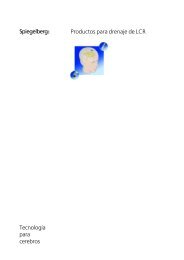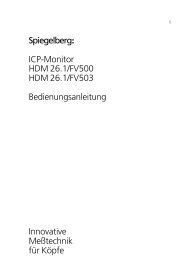P:\PA Original in Vorbereitung\ - Spiegelberg
P:\PA Original in Vorbereitung\ - Spiegelberg
P:\PA Original in Vorbereitung\ - Spiegelberg
Create successful ePaper yourself
Turn your PDF publications into a flip-book with our unique Google optimized e-Paper software.
<strong>Spiegelberg</strong>: Silverl<strong>in</strong>e<br />
Antimikrobieller Ventrikelkatheter<br />
Gebrauchs<strong>in</strong>formationen Technische Daten Wissenschaftliche Informationen<br />
Beschreibung<br />
Der antimikrobielle Ventrikelkatheter mit<br />
Hohlmandr<strong>in</strong> nach Heese besteht aus<br />
röntgendichtem Polyurethan, das mit Silber<br />
imprägniert ist. Er ist zum E<strong>in</strong>führen <strong>in</strong><br />
e<strong>in</strong>en der Hirnventrikel bestimmt. Als Zubehör<br />
gehören der Hohlmandr<strong>in</strong> , e<strong>in</strong><br />
Trokar, e<strong>in</strong> Annähflügel, e<strong>in</strong> Luer-<br />
Konnektor sowie e<strong>in</strong> Stopfen dafür zum<br />
Lieferumfang.<br />
Indikation<br />
Der Ventrikelkatheter dient der Dra<strong>in</strong>age<br />
von Liquor cerebrosp<strong>in</strong>alis sowie anderer<br />
Flüssigkeiten mit ähnlichen physikalischen<br />
Eigenschaften zur temporären Reduktion<br />
und Kontrolle des Hirndrucks.<br />
Der 8F Katheter ist für erwachsene Patienten<br />
bestimmt.<br />
Der 10F Katheter ist für solche Anwendungen<br />
bestimmt, bei denen e<strong>in</strong> höherer<br />
Blutgehalt im Liquor erwartet wird.<br />
Kontra<strong>in</strong>dikationen<br />
Der Ventrikelkatheter darf nicht zu anderen<br />
Zwecken als angegeben verwendet<br />
werden.<br />
Die Anwendung des Ventrikelkatheters ist<br />
kontra<strong>in</strong>diziert bei Infektionen der Kopfhaut,<br />
bei Patienten, die e<strong>in</strong>e Antikoagulanzientherapie<br />
erhalten sowie bei Neigung<br />
zu Blutungen. Sie ist kontra<strong>in</strong>diziert<br />
wenn e<strong>in</strong>e kont<strong>in</strong>uierliche Überwachung<br />
durch e<strong>in</strong>gewiesenes Personal nicht möglich<br />
ist.<br />
Plazieren des Ventrikelkatheters<br />
Der geeignete E<strong>in</strong>führort und die geeignete<br />
Technik s<strong>in</strong>d durch den Chirurgen<br />
auszuwählen.<br />
Das Operationsfeld aseptisch vorbereiten<br />
und Abdeckungen anbr<strong>in</strong>gen.<br />
Der Ventrikelkatheter wird mit e<strong>in</strong>geführtem<br />
Hohlmandr<strong>in</strong> plaziert. Die Marke am<br />
Hohlmandr<strong>in</strong> muß der Marke am Ventrikelkatheter<br />
gegenüberstehen. Liquorfluß<br />
aus dem Hohlmandr<strong>in</strong> zeigt die richtige<br />
Plazierung im Ventrikel. Sollte mehr Liquor,<br />
als gewünscht austreten, kann die<br />
Verb<strong>in</strong>dung zwischen Ventrikelkatheter<br />
und Hohlmanr<strong>in</strong> durch e<strong>in</strong>e Vierteldrehung<br />
des Hohlmandr<strong>in</strong>s im Ventrikelkatheter<br />
unterbrochen werden. Das distale<br />
Ende des Ventrikelkatheters wird an der<br />
Schlaucholive des Trokars angebracht.<br />
Das spitze Ende des Trokars wird durch<br />
die Inzision über dem Bohrloch e<strong>in</strong>geführt<br />
und subkutan über e<strong>in</strong>e angemessene<br />
Distanz getunnelt. Mit dem Trokar wird<br />
die Haut von <strong>in</strong>nen nach außen durchstochen.<br />
Dabei ist darauf zu achten, daß der<br />
Ventrikelkatheter nicht disloziert wird.<br />
Der Ventrikelkatheter wird durch den<br />
Tunnel gezogen, so daß ke<strong>in</strong>e Schlaufe<br />
mehr über dem Bohrloch verbleibt.<br />
Ventrikelkatheter mit atraumatischer P<strong>in</strong>zette<br />
verschließen. Annähen des<br />
Ventrikelkatheters an der Hautaustrittstelle<br />
mit Hilfe des Annähaufsatzes. Verschluß<br />
der Wunde über dem Bohrloch.<br />
Nach Kürzung des Ventrikelkatheters auf<br />
angemessene Länge wird der Luer-Konnektor<br />
mit aufgesetzter Kappe <strong>in</strong> das distale<br />
Ende geschoben und mit e<strong>in</strong>em<br />
Faden gesichert.<br />
Entfernen des Ventrikelkatheters<br />
Der Ventrikelkatheter wird durch vorsichtiges<br />
Ziehen durch den Tunnel entfernt.<br />
Warnung<br />
Der Ventrikelkatheter ist zur e<strong>in</strong>maligen<br />
Verwendung bestimmt. Nicht<br />
resterilisieren. Nicht wiederverwenden.<br />
Bei Wiederverwendung besteht e<strong>in</strong><br />
Infektionsrisiko.<br />
Nicht verwenden, wenn Packung geöffnet<br />
oder beschädigt.<br />
Beschreibung Antimikrobieller Antimikrobieller<br />
Ventrikelkatheter mit Ventrikelkatheter mit<br />
Hohlmandr<strong>in</strong> 8F Hohlmandr<strong>in</strong> 10F<br />
REF EVD 30.012.02 EVD 30.032.02<br />
Material silberimprägniertes silberimprägniertes<br />
Polyurethan Polyurethan<br />
Außendurchmesser 2.7 mm 3.3 mm<br />
Innendurchmesser 1.5 mm 1.9 mm<br />
Länge 200 mm 200 mm<br />
Tiefenmarken 50 mm 50 mm<br />
70 mm 70 mm<br />
100 mm 100 mm<br />
150 mm 150 mm<br />
Anwendungsdauer kurzzeitig<br />
bis zu 30 Tagen<br />
Enthält ke<strong>in</strong> Arzneimittel.<br />
Latexfrei<br />
Inhalt der<br />
<strong>Orig<strong>in</strong>al</strong>verpackung<br />
Doppelt verpackt 1 Ventrikelkatheter<br />
EO sterilisiert 1 Luer-Konnektor<br />
Zur e<strong>in</strong>maligen 1 geschlitzter<br />
Verwendung Annähaufsatz<br />
1 Hohlmandr<strong>in</strong><br />
1 Trokar<br />
1 Stopfen<br />
C<br />
0297<br />
EVD 30.012.02, EVD 30.032.02<br />
Hersteller<br />
<strong>Spiegelberg</strong><br />
(GmbH & Co.) KG<br />
Tempowerkr<strong>in</strong>g 4<br />
21079 Hamburg<br />
Germany<br />
Telefon: 040-790-178-0<br />
Telefax: 040-790-178-10<br />
Email: Info@<strong>Spiegelberg</strong>.de<br />
Problem<br />
Infektionen s<strong>in</strong>d e<strong>in</strong>e ernste Komplikation der<br />
Liquordra<strong>in</strong>agen. Auch bei bester OP-Technik und<br />
äußerster Hygiene am Krankenbett s<strong>in</strong>d Infektionen<br />
nicht vollständig vermeidbar (1,2,4).<br />
Die Ausstattung von Ventrikelkathetern mit e<strong>in</strong>er<br />
Komb<strong>in</strong>ation von Rifampic<strong>in</strong> und M<strong>in</strong>ocycl<strong>in</strong> reduziert<br />
die Wahrsche<strong>in</strong>lichkeit der Besiedlung des Katheters<br />
und reduziert die Häufigkeit positiver Liquorkulturen<br />
(6). Antibiotika bergen aber bei prophylaktischer Verwendung<br />
die Gefahr von Infektionen mit antibiotikaresistenten<br />
Keimen sowie opportunistischer Infektionen<br />
mit anderen Organismen wie z. B. Candida. (8).<br />
Die antiseptische Wirkung von Silber ist seit Jahrtausenden<br />
bekannt (3). Bei den zentralen Venenkathetern<br />
ist Silber schon seit längerer Zeit bewährt (Erlanger<br />
Silberkatheter).<br />
Methode<br />
Silverl<strong>in</strong>e Katheter und Sonden enthalten Silber und<br />
e<strong>in</strong> unlösliches Silbersalz. Silberionen s<strong>in</strong>d antiseptisch<br />
wirksam (3, 5) und schützen damit den Katheter<br />
vor Besiedlung und Verkeimung. Das Wirkungsspektrum<br />
ist breit. Sollten Keime unter dem E<strong>in</strong>fluss<br />
des Silbers resistent gegen Silber werden, ist die Therapie<br />
mit Antibiotika immer noch erfolgreich möglich.<br />
Durch die kle<strong>in</strong>e Partikelgröße des Silbers und des<br />
Silbersalzes ist die wirksame Oberfläche bei niedrigster<br />
Konzentration sehr groß. So werden Silberionen <strong>in</strong><br />
antimikrobieller Konzentration an der Oberfläche des<br />
Katheters freigesetzt. Dadurch wird die Oberfläche des<br />
Katheters vor Besiedlung und Verkeimung geschützt.<br />
Das Silbersalz beg<strong>in</strong>nt sofort nach Plazierung des Katheters,<br />
Silberionen <strong>in</strong> antiseptisch wirksamer Konzentration<br />
an der Oberfläche des Katheters freizusetzen.<br />
Die Silberfreisetzung aus dem metallischen Silber beg<strong>in</strong>nt<br />
erst nach Stunden, wenn die Silberfreisetzung<br />
des Silbersalzes abkl<strong>in</strong>gt. Sie hält dann aber über lange<br />
Zeit an.<br />
Silber <strong>in</strong>aktiviert die Enzymsysteme der Zellwand mit<br />
SH-Gruppen, die im transmembranösen Energiestoffwechsel<br />
aktiv s<strong>in</strong>d. Silberionen blockieren die<br />
Atmungskette der Bakterien. Weiterh<strong>in</strong> b<strong>in</strong>det Silber<br />
an die DNA-Helix und verh<strong>in</strong>dert das Spleissen (5).<br />
Ergebnis<br />
Die Silverl<strong>in</strong>e Katheter wurden mit e<strong>in</strong>er Ausrollmethode<br />
erprobt. Dabei werden Katheterstücke mit<br />
verschiedenen Erregersuspensionen geimpft. Danach<br />
werden <strong>in</strong> festgelegten Intervallen Ausrollkulturen angelegt.<br />
Als Kontrolle werden nichtantimikrobiell ausgestattete<br />
Katheterstücke dem gleichen Test unterzogen<br />
(7). Die Silverl<strong>in</strong>e Katheter zeigten antiseptische Wirkung<br />
auf<br />
- Staph. aureus,<br />
- Staph. epidermidis,<br />
- methicill<strong>in</strong>resistente Staphylokokken,<br />
- E. coli,<br />
- Pseudomonas aerug<strong>in</strong>osa,<br />
- Clostridium difficile,<br />
- Ac<strong>in</strong>etobacter baumannii,<br />
- Streptococcus <strong>in</strong>termedius,<br />
- Candida albicans und<br />
- Candida glabrata.<br />
In kl<strong>in</strong>ischen Studien konnte e<strong>in</strong>e Reduktion der<br />
Infektionsrate gezeigt werden (9, 10, 11).<br />
Diskussion<br />
Die antimikrobielle Oberflächenwirkung der Silverl<strong>in</strong>e<br />
Katheter konnte im Laborversuch e<strong>in</strong>drucksvoll gezeigt<br />
werden. Das breitbandige Wirkungsspektrum gegen<br />
die üblichen Krankenhauskeime lässt diese Technik<br />
besonders vorteilhaft ersche<strong>in</strong>en.<br />
Wegen der breitbandigen Wirkung gegen Besiedlung<br />
ohne die Gefahr von Antibiotikaresistenzen ist mit dem<br />
Silverl<strong>in</strong>e Katheter der E<strong>in</strong>satz e<strong>in</strong>es neuen Elementes<br />
im Kampf gegen die Infektionen der Ventrikelkatheter<br />
möglich geworden.<br />
Literatur<br />
1. Anneke, A.: Infektiöse Komplikationen von<br />
Liquoraußendra<strong>in</strong>agen. Dissertation Universität<br />
Heidelberg, 1999<br />
2. Lozier AP, Sciacca RR, Romagnoli MF, Connolly<br />
ES Ventriculostomy-related <strong>in</strong>fections: A critical<br />
review of literature. Neurosurgery 51, 2002, 170-<br />
182<br />
3. Naegeli, C. v.:Über die oligodynamischen Ersche<strong>in</strong>ungen<br />
an lebenden Zellen. Neue Denkschr. Allg.<br />
Schweiz. Ges. Naturwiss. 33, 1893, 174 - 182<br />
4. Pfisterer, W.;Mühlbauer, M.; Czech, T.; Re<strong>in</strong>precht,<br />
A.: Early diagnosis of external ventricular<br />
dra<strong>in</strong>age <strong>in</strong>fection: results of a prospective study. J<br />
Neurol Neurosurg Psychiatry 74, 2003, 929–932<br />
5. Thurmann, R.B.; Gerba, C.H.P.: The molecular<br />
mechanisms of copper and silver ion dis<strong>in</strong>fection of<br />
bacteria and viruses. Crit. Rev. Environmental<br />
Control, 18, 1989, 295-315<br />
6. Zabramski J.M.; Darouiche, R.O. et al.: Efficacy of<br />
antimicrobial-impregnated external ventricular<br />
catheters: a prospective, randomized, controlled<br />
trial. J Neurosurg, 98, 2003, 725-730<br />
7. Zschaler, R.: Test<strong>in</strong>g of the Antimicrobial Effect of<br />
Catheter Tub<strong>in</strong>g with a Roll Culture Method.<br />
www.spiegelberg.de/home/documents/Zschaler.pdf<br />
8. Kojic, E.M.; Darouiche, R.O.: Candida <strong>in</strong>fections<br />
of medical devices. Cl<strong>in</strong>. Microbiol. Rev., 17, 2004,<br />
255-267<br />
9. Keong, N.C.;D. Bulters, H. Richards, M.<br />
Farr<strong>in</strong>gdon, O. Sparrow, P.J. Hutch<strong>in</strong>son, J.D.<br />
Pickard, P.J. Kirkpatrick: SILVER Trial. Society of<br />
British Neurologic Surgeons, Spr<strong>in</strong>g Meet<strong>in</strong>g<br />
2010, Cambridge, Abstracts<br />
10. Lackner, P.; et al.: Efficacy of Silver Nanoparticles-<br />
Impregnated External Ventricular Dra<strong>in</strong> Catheters<br />
<strong>in</strong> Patients with Acute Occlusive Hydrocephalus.<br />
Neurocritical Care, 8, 2008, 360-365<br />
11. Izci, Y.; Secer, H.; Akay, C.; Gonul, E.: Initial<br />
experience with silver-impregnated polyurethane<br />
ventricular catheter for shunt<strong>in</strong>g of cerebrosp<strong>in</strong>al<br />
fluid <strong>in</strong> patients with <strong>in</strong>fected hydrocephalus.<br />
Neurol. Res. 2008, onl<strong>in</strong>e version.<br />
Version: 4.0 / 2010-08-02
<strong>Spiegelberg</strong>: Silverl<strong>in</strong>e<br />
Antimicrobial Ventricular Catheter<br />
Directions for Use Technical Information Scientific Information<br />
Description<br />
The antimicrobial Ventricular Catheter<br />
with Hollow Stylet is made of<br />
silverimpregnated radiopaque polyurethane.<br />
It is <strong>in</strong>tended to be <strong>in</strong>troduced<br />
<strong>in</strong>to one of the ventricles. A hollow stylet,<br />
a trocar, a butterfly suture clamp, a Luer<br />
connector, and a cap are packed with the<br />
catheter.<br />
Indication<br />
The Ventricular Catheter is <strong>in</strong>dicated for<br />
the dra<strong>in</strong>age of cerebro sp<strong>in</strong>al fluid (CSF)<br />
and other fluids of similar physical<br />
properties for reduc<strong>in</strong>g and controll<strong>in</strong>g<br />
<strong>in</strong>creased <strong>in</strong>tracranial pressure (ICP)<br />
temporarily.<br />
The 8F catheter is used for adult patients.<br />
The 10F catheter is <strong>in</strong>tended for use <strong>in</strong><br />
patients with higher blood content <strong>in</strong> the<br />
CSF.<br />
Contra<strong>in</strong>dications<br />
The device is not to be used for other<br />
purposes than <strong>in</strong>dicated.<br />
The use of the Ventricular Catheter is<br />
contra<strong>in</strong>dicated if scalp <strong>in</strong>fection is<br />
present. It is contra<strong>in</strong>dicated <strong>in</strong> patients<br />
receiv<strong>in</strong>g anticoagulants or who are<br />
known to have a risk of bleed<strong>in</strong>g.<br />
It is contra<strong>in</strong>dicated where cont<strong>in</strong>uous<br />
supervision from tra<strong>in</strong>ed personnel is not<br />
available.<br />
Placement of the Ventricular Catheter<br />
The sites of <strong>in</strong>sertion of the ventricular<br />
catheter vary. Decisions regard<strong>in</strong>g the site<br />
and technique of <strong>in</strong>sertion and verification<br />
of correct placement are to be<br />
made by the surgeon.<br />
Prepare the operative site aseptically and<br />
drape.<br />
Place the Ventricular Catheter with the<br />
hollow stylet <strong>in</strong> place. The mark at the<br />
connector of the stylet should be<br />
opposite to the mark on the ventricular<br />
catheter. Flow of CSF out of the stylet<br />
<strong>in</strong>dicates a correct position <strong>in</strong> the<br />
ventricle. If more CSF than desired is<br />
flow<strong>in</strong>g out of the stylet, turn stylet <strong>in</strong> the<br />
ventricular catheter 90 degrees. This will<br />
stop the flow. Remove the stylet.<br />
The distal end of the catheter is attached<br />
to the barbed end of the trocar. Insert the<br />
sharp end of the trocar <strong>in</strong>to the <strong>in</strong>cision<br />
over the burr hole. Tunnel<br />
subcutaneously for an appropriate<br />
distance. Br<strong>in</strong>g the trocar out through the<br />
scalp. Tak<strong>in</strong>g care not to dislodge the<br />
ventricular catheter draw it through the<br />
tunnel till the loop over the <strong>in</strong>cision no<br />
longer protrudes. Occlude catheter with<br />
shod forceps. Secure the catheter to the<br />
sk<strong>in</strong> with the butterfly connector at the<br />
exit site. Suture <strong>in</strong>cision site. Shorten the<br />
catheter appropriately and secure its distal<br />
end to the barbed end of the Luer<br />
connector with attached cap.<br />
Removal of the Ventricular Catheter<br />
Remove the catheter by carefully pull<strong>in</strong>g it<br />
out through the subgaleal tunnel.<br />
Warn<strong>in</strong>g<br />
This ventricular catheter is designed and is<br />
<strong>in</strong>tended for s<strong>in</strong>gle use. Do not resterilize.<br />
Do not reuse. With reuse an <strong>in</strong>fection<br />
risk exists.<br />
Do not use if package is damaged or<br />
opened.<br />
Description Antimicrobial Antimicrobial<br />
Ventricular Catheter Ventricular Catheter<br />
with Hollow Stylet 8F with Hollow Stylet10F<br />
REF EVD 30.012.02 EVD 30.032.02<br />
Material silverimpregnated silverimpregnated<br />
Polyurethane Polyurethane<br />
Outside Diameter 2.7 mm 3.3 mm<br />
Inside Diameter 1.5 mm 1.9 mm<br />
Length 200 mm 200 mm<br />
Depth Marks 50 mm 50 mm<br />
70 mm 70 mm<br />
100 mm 100 mm<br />
150 mm 150 mm<br />
Duration of use short term,<br />
not more than 30 days<br />
Conta<strong>in</strong>s no medication.<br />
Latex-free<br />
Package conta<strong>in</strong>s<br />
Double Packed 1 Ventricular<br />
EO Sterilized Catheter<br />
1 Luer Connector<br />
For S<strong>in</strong>gle Use 1 Cap<br />
1 Butterfly Suture Clamp<br />
1 Hollow Stylet<br />
1 Trocar<br />
C<br />
0297<br />
EVD 30.012.02, EVD 30.032.02<br />
Manufacturer<br />
<strong>Spiegelberg</strong><br />
(GmbH & Co.) KG<br />
Tempowerkr<strong>in</strong>g 4<br />
21079 Hamburg<br />
Germany<br />
Phone: +49-40-790-178-0<br />
Fax: +49-40-790-178-10<br />
Email: Info@<strong>Spiegelberg</strong>.de<br />
Problem<br />
Infections are a serious complication of CSF-dra<strong>in</strong>age<br />
systems. Even with best surgical technique and utmost<br />
aseptic handl<strong>in</strong>g measures <strong>in</strong>fections cannot be<br />
avoided completely (1, 2, 4).<br />
Impregnat<strong>in</strong>g ventricular catheters with a comb<strong>in</strong>ation<br />
of Rifampic<strong>in</strong> and M<strong>in</strong>ocycl<strong>in</strong>, or Rifampic<strong>in</strong> and<br />
Cl<strong>in</strong>damyc<strong>in</strong> reduces the likelihood of catheters to<br />
become colonized and reduces the frequency of positive<br />
CSF cultures (6). However, prophylactic use of<br />
antibiotics carries the risk of <strong>in</strong>fection with antibiotic<br />
resistant organisms <strong>in</strong>clud<strong>in</strong>g opportunistic <strong>in</strong>fection<br />
due to organisms such as candida (8).<br />
Silver as an antimicrobial substance has been known<br />
for centuries (3). It has been used <strong>in</strong> central venous<br />
catheters for some time (Erlangen Silver Catheter).<br />
Method<br />
Silver and an an <strong>in</strong>soluble silver salt are <strong>in</strong>corporated<br />
<strong>in</strong> the polyurethane or silicone material of Silverl<strong>in</strong>e<br />
Catheters and Probes. Silver ions have a strong<br />
antiseptic effect with a broad spectrum (3, 5) which<br />
protects the surface of the catheter aga<strong>in</strong>st colonization.<br />
Should a resistance to silver develop under the <strong>in</strong>fluence<br />
of the the silver ions, the antibiotic therapy will<br />
still be possible.<br />
The particles have a large specific surface result<strong>in</strong>g <strong>in</strong><br />
the release of silver ions <strong>in</strong> antiseptic concentration on<br />
the surface of the catheter to protect it from<br />
colonization.<br />
There are two phases to the release of the antiseptic<br />
agent: In phase one the silver salt releases silver ions<br />
<strong>in</strong> antiseptic concentration on the surface of the<br />
catheter. Phase one starts immediately after placement of<br />
the device and lasts for several hours. In phase two<br />
silver ions are released from the metallic silver. Phase<br />
two beg<strong>in</strong>s some hours aftert catheter placement and it<br />
lasts for a very long time.<br />
Silver <strong>in</strong>activates the enzyme systems with SH-groups<br />
of the cell wall that are active <strong>in</strong> the transmembraneous<br />
energy metabolism. Silver ions block the breath<strong>in</strong>g<br />
cha<strong>in</strong> of the bacteria (5).<br />
Results<br />
Us<strong>in</strong>g the roll-culture method Silverl<strong>in</strong>e catheters were<br />
subjected to different suspensions of bacteria for<br />
various fixed time <strong>in</strong>tervals. After that, roll-cultures<br />
were done. For control purposes non-antimicrobial<br />
catheters were subjected to the same test (7).<br />
Silverl<strong>in</strong>e catheters demonstrated antimicrobial effects<br />
on:<br />
- Staph. aureus,<br />
- Staph. epidermidis,<br />
- Methicill<strong>in</strong> resistant Staphylococcus,<br />
- E. coli,<br />
- Pseudomonas aerug<strong>in</strong>osa,<br />
- Clostridium difficile,<br />
- Ac<strong>in</strong>etobacter baumannii,<br />
- Streptococcus <strong>in</strong>termedius,<br />
- Candida albicans, and<br />
- Candida glabrata.<br />
In cl<strong>in</strong>ical studies a marked reduction of the <strong>in</strong>fection<br />
rate was found (9, 10, 11).<br />
Discussion<br />
The antimicrobial surface-effect of Silverl<strong>in</strong>e Catheters<br />
could be shown clearly <strong>in</strong> the <strong>in</strong>-vitro trial. The broad<br />
spectrum of efficacy and the two phases of release of the<br />
antiseptic agent make the product efficient and long<br />
last<strong>in</strong>g.<br />
Because of its broad band effect with no danger of<br />
resistances the Silverl<strong>in</strong>e catheters are a new approach<br />
for prevent<strong>in</strong>g EVD and shunt <strong>in</strong>fection.<br />
Bibliography<br />
1. Anneke, A.: Infektiöse Komplikationen von<br />
Liquoraußendra<strong>in</strong>agen. Dissertation Universität<br />
Heidelberg, 1999<br />
2. Lozier AP, Sciacca RR, Romagnoli MF, Connolly<br />
ES Ventriculostomy-related <strong>in</strong>fections: A critical<br />
review of literature. Neurosurgery 51, 2002, 170-<br />
182<br />
3. Naegeli, C. v.:Über die oligodynamischen Ersche<strong>in</strong>ungen<br />
an lebenden Zellen. Neue Denkschr. Allg.<br />
Schweiz. Ges. Naturwiss. 33, 1893, 174 - 182<br />
4. Pfisterer, W.;Mühlbauer, M.; Czech, T.; Re<strong>in</strong>precht,<br />
A.: Early diagnosis of external ventricular<br />
dra<strong>in</strong>age <strong>in</strong>fection: results of a prospective study. J<br />
Neurol Neurosurg Psychiatry 74, 2003, 929–932<br />
5. Thurmann, R.B.; Gerba, C.H.P.: The molecular<br />
mechanisms of copper and silver ion dis<strong>in</strong>fection of<br />
bacteria and viruses. Crit. Rev. Environmental<br />
Control, 18, 1989, 295-315<br />
6. Zabramski J.M.; Darouiche, R.O. et al.: Efficacy of<br />
antimicrobial-impregnated external ventricular<br />
catheters: a prospective, randomized, controlled<br />
trial. J Neurosurg, 98, 2003, 725-730<br />
7. Zschaler, R.: Test<strong>in</strong>g of the Antimicrobial Effect of<br />
Catheter Tub<strong>in</strong>g with a Roll Culture Method.<br />
www.spiegelberg.de/home/documents/Zschaler.pdf<br />
8. Kojic, E.M.; Darouiche, R.O.: Candida <strong>in</strong>fections<br />
of medical devices. Cl<strong>in</strong>. Microbiol. Rev., 17, 2004,<br />
255-267<br />
9. Keong, N.C.;D. Bulters, H. Richards, M.<br />
Farr<strong>in</strong>gdon, O. Sparrow, P.J. Hutch<strong>in</strong>son, J.D.<br />
Pickard, P.J. Kirkpatrick: SILVER Trial. Society of<br />
British Neurologic Surgeons, Spr<strong>in</strong>g Meet<strong>in</strong>g<br />
2010, Cambridge, Abstracts<br />
10. Lackner, P.; et al.: Efficacy of Silver Nanoparticles-<br />
Impregnated External Ventricular Dra<strong>in</strong> Catheters<br />
<strong>in</strong> Patients with Acute Occlusive Hydrocephalus.<br />
Neurocritical Care, 8, 2008, 360-365<br />
11. Izci, Y.; Secer, H.; Akay, C.; Gonul, E.: Initial<br />
experience with silver-impregnated polyurethane<br />
ventricular catheter for shunt<strong>in</strong>g of cerebrosp<strong>in</strong>al<br />
fluid <strong>in</strong> patients with <strong>in</strong>fected hydrocephalus.<br />
Neurol. Res. 2008, onl<strong>in</strong>e version.<br />
Version: 4.0 / 2010-08-02
















